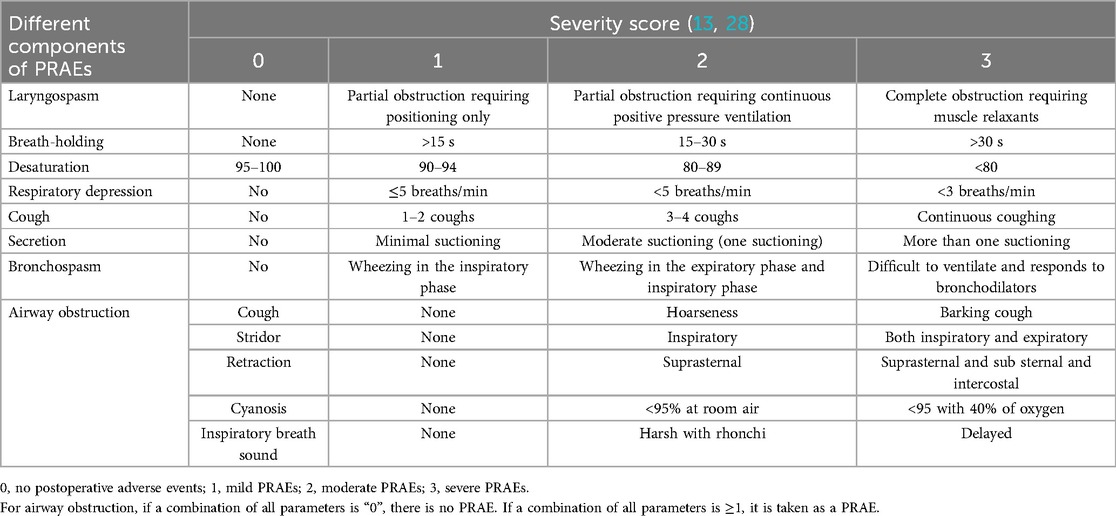- 1Anesthesia Department, College of Medicine and Health Science, Madda Walabu University, Goba, Ethiopia
- 2Anesthesia Department, Institute of Health, Bule Hora University, Bule Hora, Ethiopia
- 3School of Anesthesia, Wolaita Sodo University, Wolaita Sodo, Ethiopia
- 4Department of Anesthesia, College of Medicine and Health Science, Hawassa University, Hawassa, Ethiopia
Background: Postoperative respiratory adverse events are impairments in the normal functions of respiration resulting from the patient's condition, anesthesia, and surgery. They may be associated with postoperative complications such as cardiorespiratory arrest, extended hospital stays, and increased morbidity and mortality. Hence, we aimed to assess the incidence of postoperative respiratory adverse events and their predictors among pediatric surgical patients at Hawassa University Comprehensive Specialized Hospital (HUCSH) in 2024.
Methods: A prospective follow-up study was conducted using simple random sampling of 205 pediatric patients (aged 0–15 years). Data were collected using a structured questionnaire and analyzed using SPSS, version 26. Categorical data were analyzed using the chi-squared test and continuous data were analyzed by independent sample t-test. Multivariable regression was conducted to identify the independent predictors of postoperative respiratory adverse events. Adjusted odds ratios (AORs) and 95% confidence intervals (CIs) were used to measure the strength of association and statistical significance at a p-value <0.05.
Results: The incidence of postoperative respiratory adverse events was 35.6% among the 205 participants. Age younger than 1 month (AOR: 9.1, 95% CI: 1.3–12.5), age 1 month–2 years (AOR: 3.6, 95% CI: 5.8–16.1), upper respiratory tract infections (AOR: 3.2, 95% CI: 1.4–9.93), intraoperative opioid analgesics (AOR: 2.53, 95% CI: 1.2–5.97), use of a cuffed endotracheal tube (AOR: 3.97, 95% CI: 1.4–11.6), and spontaneous ventilation techniques (AOR: 8.53, 95% CI: 2.9–24.9) were independent predictors of postoperative respiratory adverse events.
Conclusion: The incidence of postoperative respiratory adverse events was high. Age younger than 2 years, upper respiratory tract infections, intraoperative opioid use, use of cuffed endotracheal tubes, and spontaneous ventilation techniques were independent predictors of postoperative respiratory adverse events. Proper preoperative optimization, avoiding cuffed endotracheal tubes (for infants <2 years), implementing multimodal analgesia, and the use of controlled ventilation may reduce the incidence of postoperative respiratory adverse events.
Introduction
Adverse events are defined as alterations in a patient's health condition that result in undesirable, unintentional signs or symptoms, disease, or laboratory abnormalities following surgery, anesthesia, or medications, and the occurrence is not due to a related, exact underlying cause (1).
Postoperative respiratory adverse events (PRAEs) are the most common postoperative complications encountered during pediatric anesthesia, with a higher occurrence during recovery from anesthesia or the postoperative period (2). The incidence of children experiencing a dynamic occurrence of PRAEs ranges from 2.8% to 41% (3–5). The incidence of PRAEs varies across different types of surgical procedures and interventions, time, and anesthetic techniques (6–8).
Age less than 1 year, a higher American Society of Anesthesiologists (ASA) class, duration of anesthesia, obesity, upper respiratory tract infections, neuromuscular diseases, and preoperative history of bronchial asthma were considered predictors of PRAEs (6, 9, 10).
In addition, the urgency of surgery may be associated with postoperative respiratory adverse events, which may be due to increased aspiration risk, associated airway complications, and other factors such as hemodynamic instability that may lead to emergency surgery (7). Various intraoperative factors can influence the occurrence of postoperative adverse respiratory events following general anesthesia, including anesthetic medications, modes of ventilation, and airway management devices used (6).
Pediatric populations are highly susceptible to morbidity and mortality following the occurrence of postoperative respiratory adverse events due to their anatomical and physiological immaturity compared to adults. Reduced functional residual capacity and lung compliance leading to inadequate breathing and oxygenation during anesthesia, episodes of compromised ventilation, and a high incidence of airway challenges encountered in this population may result in a higher propensity for postoperative respiratory adverse events such as hypoxemia (11, 12).
Inadequate diagnosis and management of postoperative respiratory adverse events may result in hypoxia, reintubation, cardiorespiratory arrest, hypoxic brain injury, intensive care unit (ICU) admission for mechanical ventilation, extended hospital stay, and increased medical expenses (10). Furthermore, PRAEs may result in financial strain due to more outpatient care and re-hospitalizations prolonged, extended hospital stay, psychological strain on the patient and family, stress on the care providers caring for the child, and an increase in morbidity and mortality (2).
Recently, the anesthetic management of pediatric patients has significantly improved due to the presence of context-insensitive anesthetic medications such as remifentanyl, invasive monitoring devices such as arterial blood gas analysis, and capnography, which aid in early detection and management and may reduce the consequences and severity of respiratory adverse events. Hence, failure to recognize it or delayed interventions may lead to catastrophic cardiorespiratory arrest, anoxic brain injury, mortality, brain death, cardiovascular complications, ICU admission for mechanical ventilation, extended hospital stay, and increased expenses. However, there is a lack of studies that have been conducted on postoperative respiratory adverse events in middle-to-low-income countries, which may result in inadequate information regarding the incidence and predictors of postoperative respiratory adverse events. Hence, it is crucial to determine the incidence of PRAEs and identify their predictors to make recommendations for early prevention, diagnosis, and management, which may prevent the occurrence or minimize the incidence of postoperative respiratory adverse events. This may also lead to fair resource allocation, including manpower, invasive monitoring, and ventilators for vulnerable patients.
Furthermore, as far as a safe and smooth postoperative course is concerned with maximizing patient safety, reducing the incidence of PRAEs may decrease the morbidity and mortality associated with PRAEs among pediatric patients who have undergone surgery, and focusing on the predictors of PRAEs may reduce the severity and improve postoperative outcomes.
The objective of this study was to assess the incidence of postoperative respiratory adverse events and their predictors in surgical pediatric patients at Hawassa University Comprehensive Specialized Hospital (HUCSH) in 2024.
Method and materials
Study area and study period
This study was conducted at the Hawassa University Comprehensive Specialized Hospital, which is located 275 km from Addis Ababa, Ethiopia, between 1 January and 30 March 2024. It is one of the universities in southern Ethiopia that provides services in different specialties and teaches healthcare professionals in different sectors. There are six major operation rooms, including an emergency operation room, two cesarean section operation rooms, two orthopedic rooms, and an ophthalmology operation room, in the hospital.
Study design
A prospective follow-up study was conducted to assess the incidence and predictors of PRAEs at HUCSH.
Population
Source population
All pediatric patients who were operated on at Hawassa University Comprehensive Specialized Hospital.
Study population
In total, 205 pediatric patients who underwent surgery under general anesthesia at Hawassa University Comprehensive Specialized Hospital during the data collection period were enrolled.
Inclusion and exclusion criteria
Inclusion criteria
Pediatric patients who were operated on under general anesthesia at HUCSH during data collection.
Exclusion criteria
• ASA class ≥III.
• Pediatrics with acute respiratory distress.
• Pediatrics with congenital anomalies (e.g., VACTREL syndrome) and neurological anomalies, such as Chiari malformation.
• Pediatrics preoperatively on oxygen and who required mechanical ventilation.
• Severe head injury.
• Major trauma (causing prolonged disability or death).
Operational definition
Airway obstruction: Symptoms of cough, stridor, retraction, inspiratory (breathing in) sound, cyanosis, or a score ≥1 (13).
Anemia: A clinical scenario in which hemoglobin levels are <11 mg/dl for children aged <1 month, <11 mg/dl for 1–4 years, 11.5 mg/dl for 5–11 years, <12 mg/dl for 12–14 years, and <13 mg/dl for >15 years (14, 15).
Body mass index (BMI): Underweight if <2nd percentile for age less than 1 month and <5th percentile for age >1 month, normal between 2nd and 85th percentile for age <1 month and between 5th and 85th percentile for age >1 month, overweight if between 85th and 95th percentile for age >1 month and >85th percentile for age <1 month, and obese if >95th percentile for age >1 month (16, 17).
Breath-holding: Cessation of breathing for more than 15 s associated with a heart rate of <80 beats per min (18).
Coughing: Persistent coughing for 10 s.
Desaturation: Oxygen saturation <95% more than 30 s as measured by pulse-oximetry, regardless of oxygen administration (19).
Laryngospasm: Partial or complete airway obstruction and chest rigidity response to positive pressure ventilation after bag-mask ventilation or succinylcholine (20).
Respiratory adverse event: Any episodes of desaturation, partial or total airway obstruction, continuous coughing, breath-holding, bronchospasm, or stridor (21, 22).
Respiratory depression: Respiratory rate ≤5 breaths/min with oxygen saturation ≤85% for ≥3 min (23).
Pediatrics: Age classified as 0–15 years old (24). The age groups can be described as: 0–1 month, 1 month–2 years, 2–12 years, and above 12 years (25, 26).
Postoperative period: The time period immediately following surgery or within 60 min of the end of surgery.
Postoperative stridor, high pitch: Barky cough or hoarseness develops within the first few hours after extubation (27).
Sample size determination and sampling techniques
Sample size determination
The sample size was calculated using single-population formulae by taking the probability of postoperative respiratory adverse events as 50%, as there were no previous studies conducted on postoperative respiratory adverse events, z α/2 = 0.96, margin of error (d) = 0.05, and n = z2 × p (1 − p)/d2. A sample size of 384 was obtained using this formula. Using the finite population formula, n = n/1 + n/N = 384/1+384/356 = 186, where n is the sample size, and N is the number of pediatric patients operated under general anesthesia from January to March 2023 at HUCSH, and adding a 10% non-response rate. Thus, the final sample size was 205.
Sampling techniques
All pediatric patients who met the inclusion criteria were included in the study using simple random sampling.
Variables of the study
Dependent variable
Postoperative respiratory adverse events
Independent variables
Sociodemographic factors, such as age, sex, weight, height, and BMI.
Preoperative predictors included ASA class, anemia, personal and family history of bronchial asthma, and preoperative upper respiratory tract infections.
The intraoperative predictors included airway devices, intraoperative medication use, type of procedure, intraoperative ventilation techniques, and estimated blood loss.
Data collection tools and techniques
Data were collected after orientation was given to data collectors (two BSc nurse professionals who were not involved in patient management and two BSc anesthesia professionals) and one MSc anesthesia supervisor. Data were collected using a structured questionnaire comprising sociodemographic data (age, sex, weight, height, and body mass index) and preoperative predictors (ASA class, history of upper respiratory tract infections, preoperative hemoglobin, preoperative hematocrit, and self- and family history of bronchial asthma), which were obtained from patient or family interviews and reviewing patient charts and preoperative anesthesia record sheets, and recorded. Intraoperative predictors, including duration of surgery, induction drugs, maintenance agents (such as intravenous, inhalational, and muscle relaxants), reversal agent administered, analgesic agents used {opioids, caudal block, combined caudal block and paracetamol, combined caudal block and opioids, and other pain management techniques [transverse abdominis plane (TAP) block, sciatic nerve block, and diclofenac]}, type of procedure [ophthalmology surgery; general pediatric surgery; ear, nose, and throat (ENT) surgery; neurosurgery; and others (orthopedic, plastic, reconstructive, maxillofacial, and vascular surgery)], techniques of ventilation (spontaneous ventilation and controlled ventilation), airway devices used [including face mask, laryngeal mask airway (LMA)], cuffed/uncuffed endotracheal tube, tube size, laryngeal mask airway size, estimated blood loss, and fluid type were obtained by reviewing the operation notes, surgery/anesthesia record logbook, and intraoperative anesthesia record chart.
Postoperative respiratory adverse events were recorded during the follow-up time starting from the emergence from anesthesia to the post-anesthesia care unit (PACU) and or neonatal intensive care unit (NICU) stay over 60 min, i.e., within the first 5 min following waking after extubation, 10 min after extubation, immediately at admission to PACU or NICU, 5 min after admission to PACU or NICU, and then at 10, 15, 20, 30, 40, 50, and 60 min after admission. Postoperative respiratory adverse events were assessed using the scoring systems described in Table 1 as measured by pulse-oximetry. Hence, a single episode (any episode ≥1 score) or occurrence of any one of the respiratory adverse events, such as laryngospasm, desaturation/hypoxemia, stridor, croup, breath-holding, continuous coughing, airway obstruction, and respiratory depression (13, 28), were considered as postoperative respiratory adverse events for a given parameter (Table 1).
Data management, processing, and analysis
After the completeness of the questionnaire was checked manually and coded, the data were entered into EpiData, version 4.6, and exported to SPSS Windows, version 26, for data processing and analysis. The reliability of the data collection tools was checked using Cronbach's alpha (α = 0.73), which indicated that the data were reliable. Descriptive categorical data are presented as frequencies and percentages, and normally distributed continuous data are presented as means and standard deviations. Kolmogorov–Smirnov and Shapiro–Wilk tests were used to check the normality of the data distribution. Categorical data were analyzed using the chi-squared test, and normally distributed continuous data were analyzed using an independent sample t-test. Binary logistic regression was used to identify the predictors of postoperative respiratory adverse events. Bivariate logistic regression analysis was conducted to select candidate variables for multivariable analysis and to obtain crude associations. Variables with a p-value of <0.25 on the bivariate logistic regression analysis, were simultaneously entered into the multivariable logistic regression analysis using the backward stepwise model-building techniques to determine the independent predictors and adjusted association by controlling for confounders. Model fitness was checked using the Hosmer and Lemeshow goodness-of-fit test (p-value >0.05, showed that the model best fit the variables), and multicollinearity was assessed using the variance inflation factor and tolerance test. In the final model, adjusted odds ratios (AORs) and 95% confidence intervals (CIs) were used to measure the strength of the associations and statistical significance, respectively, with a p-value of <0.05.
Ethical consideration
The ethics letter to conduct this study was obtained from Hawassa University Institutional Review Board (Ref. no. IRB/065/16). Written informed consent was obtained from each participant's parents/legal guardians, and the study was approved by the ethics committee in accordance with the Declaration of Helsinki. Names or any other personal identifiers of the study participants were not included.
Results
Sociodemographic characteristics of the study participants
A total of 205 pediatric patients were included in the study, with a response rate of 202 (98.5%). More than half (60.5%) of the study participants were male, with two-thirds (65.4%) of the study participants aged between 2 and 12 years (Table 2).

Table 2. Sociodemographic characteristics of pediatric patients operated on under general anesthesia at HUCSH, 2024 (n = 205).
Incidence of postoperative respiratory adverse events among pediatric patients operated on under general anesthesia at HUCSH
The incidence of postoperative respiratory adverse events among the pediatric patients operated on under general anesthesia at HUCSH was 73 (35.6%) [95% CI (28.8–42.9)] (Figure 1).
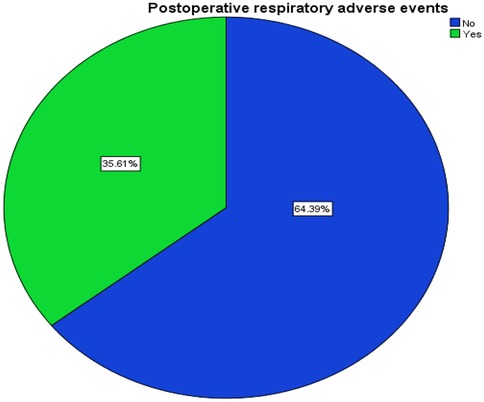
Figure 1. Incidence of postoperative respiratory adverse events among pediatric patients operated on under general anesthesia at HUCSH, 2024.
Incidence of postoperative respiratory adverse events during the follow-up time of among pediatric patients operated on under general anesthesia at HUCSH
The incidence of postoperative respiratory adverse events was the highest (54.7%) within the first 5 min of waking after extubation, followed by 5 min after admission to the post-anesthesia care unit (16%) (Figure 2).
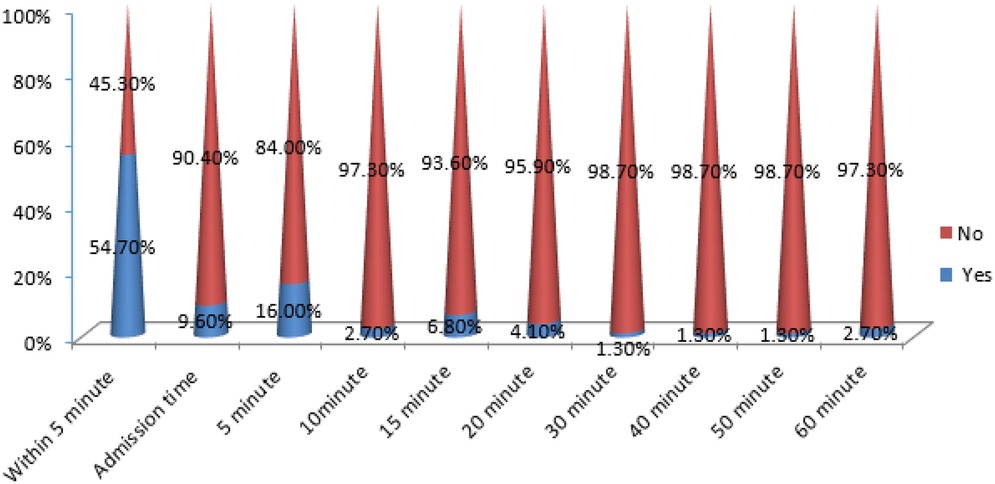
Figure 2. Incidence of postoperative respiratory adverse events during the follow-up time among pediatric patients operated on under general anesthesia at HUCSH, 2024.
Regarding the episodes of PRAEs that occurred during the follow-up time, the most prevalent adverse events were oxygen desaturation (72.5%), followed by airway obstruction (32.29%), secretion (25%), and laryngospasm (15.6%) in the first 1–5 min during the emergence period. The incidence of desaturation, secretion airway obstruction, and breath-holding was 42.86%, 28.6%, 16.5%, and 14.3% during admission time to the post-anesthesia care unit or neonatal intensive care unit, respectively. After 1 h in the post-anesthesia unit or neonatal intensive care unit, only 2.7% of the participants had experienced airway obstruction (Figure 3).
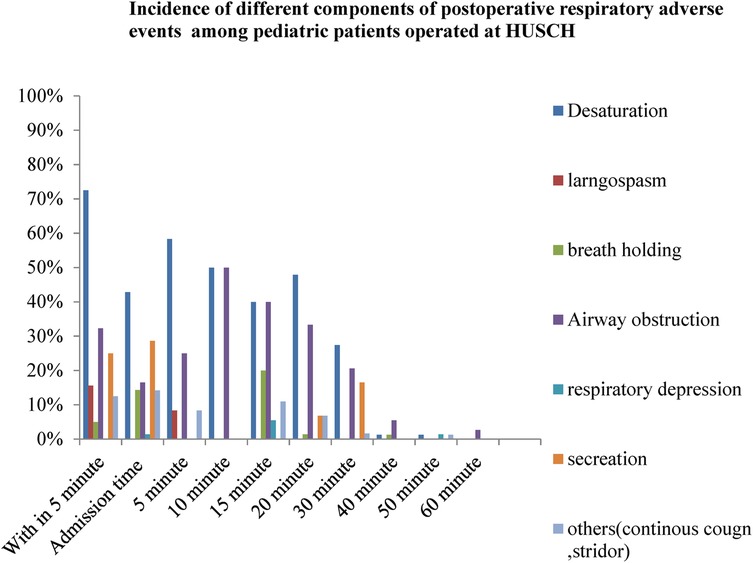
Figure 3. Proportion of different components of postoperative respiratory adverse events during the follow-up time among pediatric patients operated on under general anesthesia at HUCSH, 2024.
Preoperative predictors
The majority (83.4%) of the study participants were ASA I and the rest (16.6%) were ASA II. More than three-fourths (80.5%) of the study participants underwent elective procedures and one-fifth (19.5%) of the study participants underwent emergency procedures. Nearly one-third (30.5%) of study participants had a family history of bronchial asthma. The preoperative mean hemoglobin and hematocrit levels of the study participants were 12.5 ± 1.6 and 35.2 ± 4.27, respectively (Table 3).

Table 3. Preoperative predictors of postoperative respiratory adverse events among pediatric patients operated on under general anesthesia at HUCSH, 2024 (n = 205).
Intraoperative predictors
As the distribution of the intraoperative predictors revealed, the majority (86.3%) of the study participants underwent surgery within 2 h. More than half (60.5%) of the study participants were induced with propofol, while more than half (57.1%) of the participants were maintained with isoflurane. Nearly three-fourths (72.2%) of the study participants received muscle relaxants with more than half (60.1%) receiving succinylcholine. Regarding the intraoperative analgesics used, nearly half (46.3%) of the study participants were administered paracetamol, and one-third (35.1%) were administered sole opioids (Table 4).
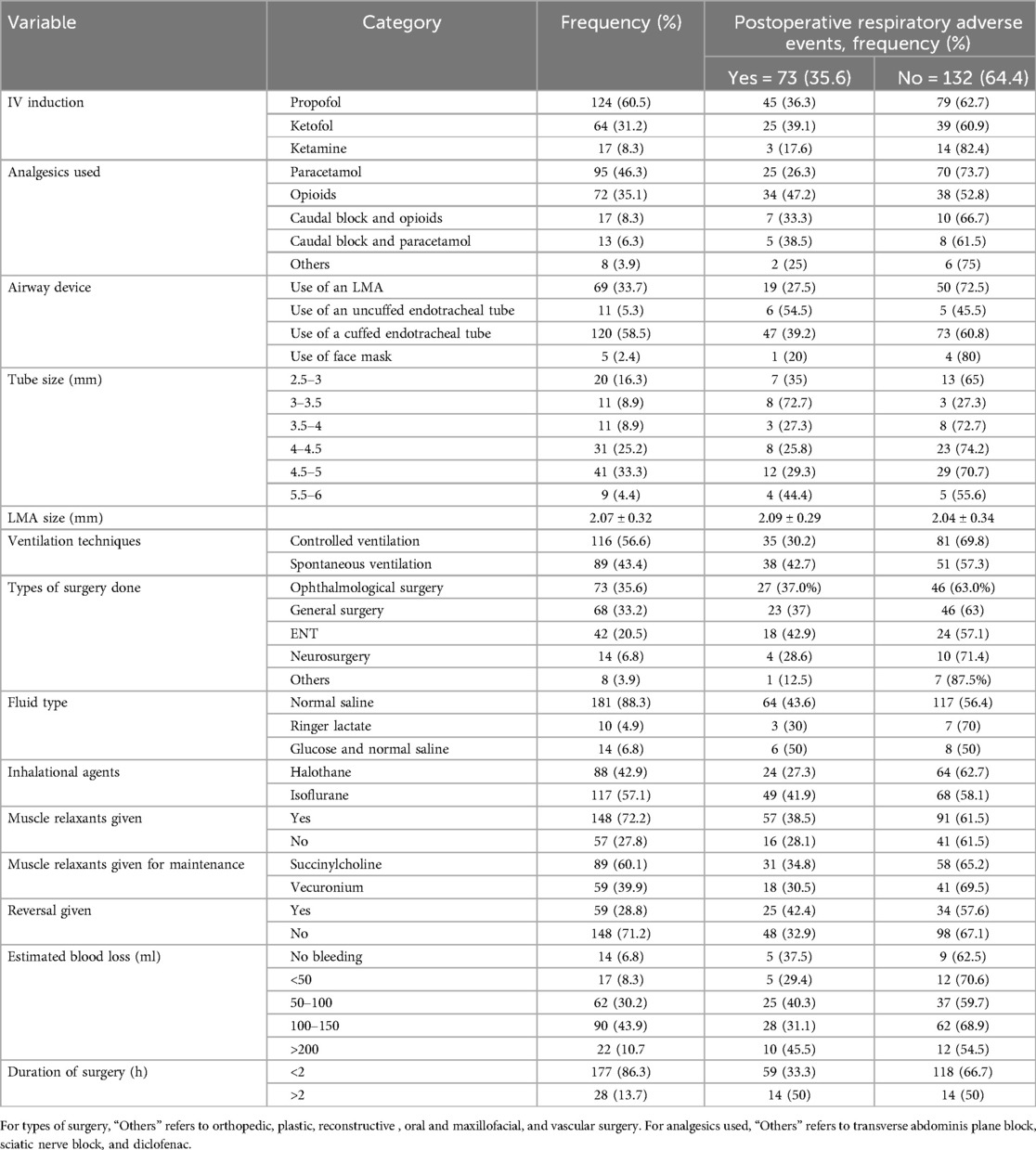
Table 4. Intraoperative predictors of postoperative respiratory adverse events among pediatric patients operated on under general anesthesia at HUCSH, 2024 (n = 205).
Ophthalmologic surgery was the predominant (35.6%) type of surgical procedure conducted among pediatric patients, followed by general surgery (33.2%), ENT surgery (20.5%), and neurosurgery (6.8%). Nearly three-fourth (71.8%) of the study participants were intubated with a cuffed endotracheal tube, followed by laryngeal mask airways (33.7%); one thirds (32.1%) of the study participants were experienced controlled ventilation. The mean LMA size used was 2.07 ± 0.32 mm. Nearly half (43.9%) of the study participants experienced an estimated intraoperative blood loss of 100–150 ml (Table 4).
Predictors of postoperative respiratory adverse events among pediatric patients operated on under general anesthesia at HUCSH
Bivariate logistic regression was conducted to select candidate variables for multivariate logistic regression using crude association. Hence, sex, age, American Society of Anesthesiologist class, duration of surgery, muscle relaxant used for maintenance, inhalational agents, upper respiratory tract infection, self- and family history of bronchial asthma, intraoperative analgesics administered, airway devices, ventilation techniques, types of surgery, reversal agent used, and preoperative hemoglobin were associated with postoperative respiratory adverse events (p < 0.25) (Table 5). These variables were simultaneously entered into a multivariable regression analysis using backward stepwise model-building techniques.
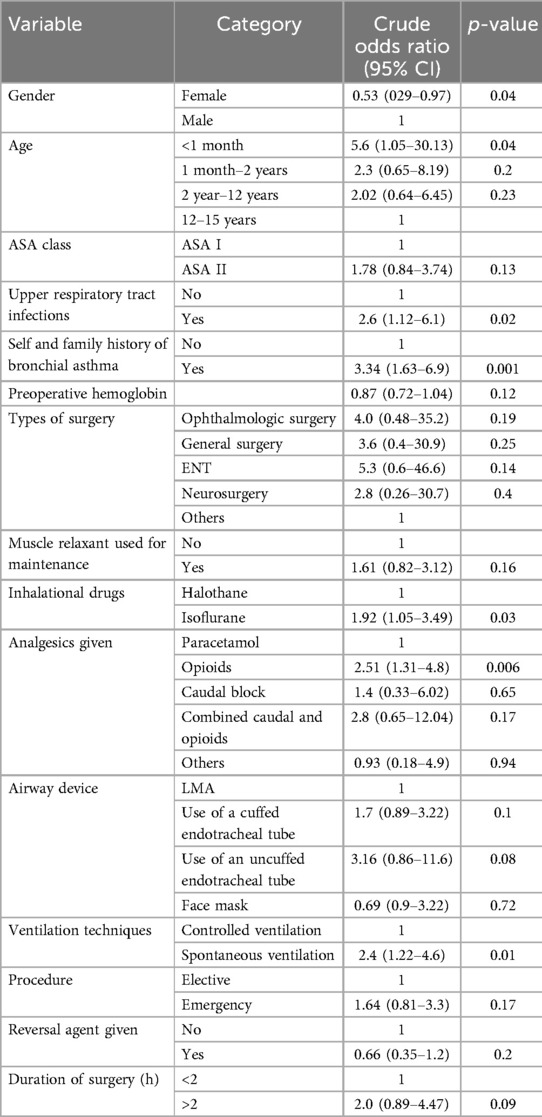
Table 5. Results of bivariate logistic regression of predictors of postoperative respiratory adverse events among pediatric patients operated on under general anesthesia at HUCSH, 2024 (n = 205).
Independent predictors of postoperative respiratory adverse events among pediatric patients operated on under general anesthesia at HUCSH
Multivariable logistic regression was used to identify independent predictors of postoperative respiratory adverse events. Hence, an age of less than 2 years, preoperative history of upper respiratory tract infections, intraoperative opioid analgesics, use of cuffed endotracheal tubes, and spontaneous ventilation techniques were independent predictors of postoperative respiratory adverse events (p < 0.05) (Table 6).
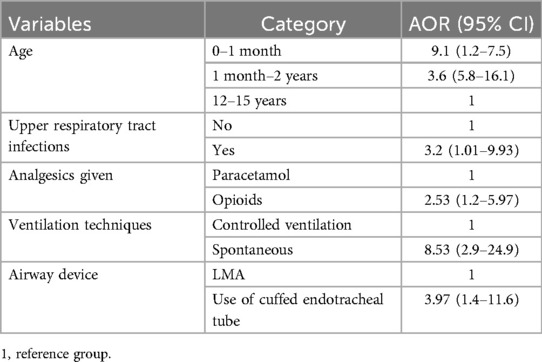
Table 6. Results of multivariable logistic regression of independent predictors of postoperative respiratory adverse events among pediatric patients operated on under general anesthesia at HUCSH, 2024 (n = 205).
The study participants who were younger than 1 month were 9.1 times (AOR: 9.1, 95% CI: 1.3–12.5) and those 1 month–2 years were 3.6 times (AOR: 3.6, 95% CI: 5.8–16.1) more likely to experience postoperative respiratory adverse events than those older than 12 years. The study participants who had a history of preoperative upper respiratory tract infections were 3.2 times (AOR: 3.2, 95% CI: 1.4–9.93) more likely to develop postoperative respiratory adverse events as compared to those who had no history of preoperative upper respiratory tract infections (normal).
The study participants who were administered intraoperative opioid analgesics were 2.53 times (AOR: 2.53, 95% CI: 1.2–5.97) more likely to experience postoperative respiratory adverse events than those who were administered paracetamol.
The study participants who experienced spontaneous ventilation techniques were 8.53 times (AOR: 8.53, 95% CI: 2.9–24.9) more likely to develop postoperative respiratory adverse events compared to those managed with controlled ventilation. The study participants who were intubated with a cuffed endotracheal tube were 3.97 times (AOR: 3.97, 95% CI: 1.4–11.6) more likely to develop postoperative respiratory adverse events as compared to those who had airway management with LMA (Table 6).
Discussion
In the current study, the incidence of postoperative respiratory adverse events was 35.6% [95% CI (28.8–42.9)]. The result of this study is consistent with that of studies conducted in Turkey, the USA, and Ontario, Canada, which found incidence rates of postoperative respiratory adverse events of 29.9%, 31%, and 41%, respectively (4, 5, 7).
The result of this study was higher than a retrospective observational study conducted by Yi et al. in 2023 in China (6.9%) (29). This may be due to the type of surgical procedure conducted, the setting difference (advanced experience in anesthesia management and the use of invasive monitoring), the difference in outcome assessment (the previous study assessed laryngospasm and bronchospasm, considering them to be major PRAEs), and the difference in the study design, since our study was prospective follow-up study and we assessed both minor and major postoperative respiratory adverse events.
Similarly, the result of our study was higher than the result of a retrospective study conducted by Tsampalieros et al. in Canada, in 2022 (17.6%) (30). This difference might be due to differences in the study population, use of invasive monitoring, preoperative polysomnography, and study design (the previous study was retrospective).
This study found that an age of <2 years was a predictor of postoperative adverse respiratory events. This finding is supported by a study conducted by Baker et al. in 2022, which showed that children under 3 years were four times more likely to develop postoperative respiratory adverse events than older children (aged 12–15 years) (31). The possible explanations for the high vulnerability in this age group may be the anatomical, physiological, pharmacological, and immunological differences in younger children compared to older children. Hence, these might increase the vulnerability of younger children to postoperative respiratory adverse events, which result from immature control of breathing, higher flow resistance, airway collapsibility, increased chest wall compliance, reduced gas exchange, and increased breathing work.
Preoperative upper respiratory tract infections were found to be a predictor of postoperative respiratory adverse events, which is consistent with a previous retrospective study conducted by Lee et al. in South Korea in 2020 (32) that showed that patients with upper respiratory tract infections experienced five times more postoperative respiratory adverse events than patients without upper respiratory tract infections. This may be related to upper respiratory tract infection-induced upper airway hyperactivity, increased closing volume, and impaired diffusion capacity.
Intraoperative opioid analgesics were risk factors for postoperative respiratory adverse events. This finding is similar to that of a study conducted in the USA by Voepel-Lewis et al. (33), which revealed that among 25 children who were administered opioids, 68% experienced oxygen desaturation and 28% experienced postoperative respiratory depression, and they had a four times higher oxygen requirement than the non-opioid group. Similarly, the result of the current study is supported by a study conducted in Korea, which showed that the risk of developing postoperative respiratory adverse events was two to three times higher among patients who had taken opioids than among those who had taken paracetamol or paracetamol combined with opioids (34). A possible explanation for this may be the effect of opioids in decreasing the central respiratory drive to the respiratory muscles, upper airway dilatation, reduced airway tone, and reduced central chemosensitivity response to hypoxia and hypercapnia (35).
In this study, the use of cuffed endotracheal tubes was significantly associated with postoperative respiratory adverse events. This finding is consistent with the results of a study conducted by Li et al. (36). This could be due to airway simulation during intubation, laryngoscopy, and suctioning associated with intubation and extubation, resulting in hyperactivity of the upper airway, anatomical distortion, and mechanical impairments of the airway structures, especially during extubation.
The novel finding of this study is that spontaneous ventilation techniques are independent predictors of postoperative respiratory adverse events in pediatric patients following surgery. This may be due to higher respiratory effort, resulting in exhaustion of the respiratory muscles and ineffective gas exchange associated with spontaneous ventilation.
Strength and limitations of study
Loss-to-follow-up bias was minimal in this study. We studied the overall incidence of postoperative adverse respiratory events (multiple outcomes were considered) in the first 60 min after emergence from anesthesia and may have overlooked some adverse events that did not occur within this defined follow-up time.
The short follow-up period limits us in assessing the incidence of PRAEs that occur beyond 60 min. Thus, future researchers should consider longer postoperative follow-up time to assess the incidence of PRAEs that occur beyond 60 min in the postoperative period. Therefore, future studies should consider specific postoperative adverse events within a reasonably defined time of occurrence. Furthermore, most of the postoperative respiratory adverse events were interrelated, which is a limitation of this study, as we were not able to address the cause–effect relationship. The use of only pulse-oximetry to assess postoperative adverse respiratory events (such as desaturation and hypoxia) may affect the interpretation of the results as this may introduce bias.
Conclusion and recommendations
The incidence of postoperative respiratory adverse events in pediatric patients who underwent surgery under general anesthesia at HUCSH was high. Age younger than 2 years, preoperative history of upper respiratory tract infections, use of intraoperative opioid analgesics, airway management with cuffed endotracheal tubes, and spontaneous ventilation techniques were independent predictors of postoperative respiratory adverse events. Hence, anesthesia providers should thoroughly assess preoperative upper respiratory tract infections in pediatric patients who have undergone surgery and provide appropriate optimization strategies prior to surgery. The use of multimodal analgesia, rather than opioids alone, for pain management may decrease the incidence of postoperative respiratory adverse events. Airway management using uncuffed endotracheal tubes (in infants younger than 2 years), and the use of controlled ventilation may reduce the incidence of PRAEs. Furthermore, we hope that the limitations of the current study will be addressed by future researchers.
Data availability statement
The original contributions presented in the study are included in the article/Supplementary Material, further inquiries can be directed to the corresponding author.
Ethics statement
The studies involving humans were approved by Hawassa University Institutional Review Board. The studies were conducted in accordance with the local legislation and institutional requirements. Written informed consent for participation in this study was provided by the participants’ legal guardians/next of kin.
Author contributions
TH: Conceptualization, Data curation, Formal analysis, Funding acquisition, Investigation, Methodology, Project administration, Resources, Software, Supervision, Validation, Visualization, Writing – original draft, Writing – review & editing. AT: Conceptualization, Data curation, Methodology, Project administration, Resources, Supervision, Validation, Visualization, Writing – original draft. MB: Conceptualization, Data curation, Funding acquisition, Methodology, Project administration, Resources, Software, Supervision, Validation, Visualization, Writing – review & editing. KW: Conceptualization, Data curation, Formal analysis, Funding acquisition, Investigation, Methodology, Project administration, Resources, Software, Supervision, Validation, Visualization, Writing – review & editing. WB: Conceptualization, Data curation, Formal analysis, Funding acquisition, Investigation, Methodology, Project administration, Resources, Software, Supervision, Validation, Visualization, Writing – original draft. GA: Conceptualization, Data curation, Formal analysis, Investigation, Methodology, Resources, Supervision, Validation, Visualization, Writing – review & editing. DD: Data curation, Investigation, Project administration, Resources, Supervision, Validation, Visualization, Writing – original draft. KM: Conceptualization, Data curation, Funding acquisition, Methodology, Project administration, Resources, Supervision, Validation, Visualization, Writing – review & editing. OA: Data curation, Investigation, Project administration, Resources, Validation, Visualization, Writing – review & editing. MK: Conceptualization, Data curation, Formal analysis, Funding acquisition, Investigation, Methodology, Project administration, Resources, Software, Supervision, Validation, Visualization, Writing – review & editing. TI: Conceptualization, Data curation, Formal analysis, Funding acquisition, Investigation, Methodology, Project administration, Resources, Software, Supervision, Validation, Visualization, Writing – original draft, Writing – review & editing.
Funding
The author(s) declare that no financial support was received for the research and/or publication of this article.
Acknowledgments
We would like to thank our study participants for giving us their valuable time and Hawassa University College of Medicine and Health Science for their continuous support during the research process.
Conflict of interest
The authors declare that the research was conducted in the absence of any commercial or financial relationships that could be construed as a potential conflict of interest.
Generative AI statement
The author(s) declare that no Generative AI was used in the creation of this manuscript.
Publisher's note
All claims expressed in this article are solely those of the authors and do not necessarily represent those of their affiliated organizations, or those of the publisher, the editors and the reviewers. Any product that may be evaluated in this article, or claim that may be made by its manufacturer, is not guaranteed or endorsed by the publisher.
Abbreviations
ASA, American Society of Anesthesiologists; BMI, body mass index; HUCSH, Hawassa University Comprehensive Specialized Hospital; ICU, intensive care unit; PRAEs, postoperative respiratory adverse events.
References
1. Wang F. The definition of adverse events and major postoperative complications. BMJ Open. (2023) 13:e073038. doi: 10.1136/bmjopen-2023-073038
2. My L, Chaiyakunapruk N. The lancet regional health—western Pacific urgent need to take action on reducing postoperative respiratory complications. Lancet Reg Health West Pac. (2021) 10:100136. doi: 10.1016/j.lanwpc.2021.100136
3. Hamilton TB, Thung A, Tobias JD, Jatana KR, Raman VT. Adenotonsillectomy and postoperative respiratory adverse events: a retrospective study. Laryngoscope Investig Otolaryngol. (2020) 5(1):168–74.32128445
4. Kozanhan B, Iyisoy MS. Red cell distribution width as a novel predictor of postoperative respiratory adverse events after adenotonsillectomy. Paediatr Anaesth. (2017) 27(6):609–15.28345782
5. Yalamanchili R, Osterbauer B, Hochstim C. Postoperative respiratory adverse events in children after endoscopic laryngeal cleft repair. Eur Arch Otorhinolaryngol. (2022) 279(5):2689–93. doi: 10.1007/s00405-021-07250-1
6. Tao S, Zhang T, Wang K, Xie F, Ni L, Mei Z, et al. Identification of the risk factors in perioperative respiratory adverse events in children under general anesthesia and the development of a predictive model. Transl Pediatr. (2021) 10(7):1877–82.34430435
7. Fishman H, Hamid JS, Barrowman N, Momoli F, Maclusky I. Associations between polysomnography measurements and postoperative adverse respiratory events in children with neuromuscular disease. J Clin Sleep Med. (2021) 17(4):757–65.33231163
8. Pehora C, Faraoni D, Amin R, Sayal A, Donnell CM. Predicting perioperative respiratory adverse events in children with sleep-disordered breathing. Anesth Analg. (2021) 132(4):1084–91.33002926
9. Woods BD, Sladen RN. Perioperative considerations for the patient with asthma and bronchospasm. Br J Anaesth. (2009) 103(Suppl. 1):i57–65. doi: 10.1093/bja/aep271
10. Wulff I, Duah HO, Tutu HO, Ofori-amankwah G, Yankey KP, Owiredu MA, et al. Postoperative pulmonary complications in complex pediatric and adult spine deformity: a retrospective review of consecutive patients treated at a single site in West Africa. Global Spine J. (2021) 8:1208–14.
11. Engelhardt T, Virag K, Veyckemans F, Habre W. Airway management in paediatric anaesthesia in Europe—insights from APRICOT (anaesthesia practice in children observational trial): a prospective multicentre observational study in 261 hospitals in Europe. Br J Anaesth. (2018) 121(1):66–75.29935596
12. Ayad S, Khanna AK, Iqbal SU, Singla N. Characterisation and monitoring of postoperative respiratory depression: current approaches and future considerations. Br J Anaesth. (2019) 123(3):378–91.31331649
13. Preutthipan A, Poomthavorn P, Sumanapisan A, Chinrat B, Thasuntia S, Plitponkarnpim A, et al. A prospective, randomized double-blind study in children comparing two doses of nebulized L-epinephrine in postintubation croup. J Med Assoc Thail. (2005) 88(4):508–12.
14. Li H, Xiao J, Liao M, Huang G, Zheng J, Wang H, et al. Anemia prevalence, severity and associated factors among children aged 6–71 months in rural Hunan province, China: a community-based cross-sectional study. BMC Public Health. (2020) 20(1):1–13.31898494
15. Wang M, San C, Diego S. Iron deficiency and other types of anemia in infants and children. Am Fam Physician. (2016) 93(4):270–8.26926814
16. Hywell D, Caroline R, Louisa E. A Simple Guide to Classifying Body Mass index in Children. Oxford: National Obesity Observatory (2011).
18. Wudineh DM, Berhe YW, Chekol WB, Adane H, Workie MM. Perioperative respiratory adverse events among pediatric surgical patients in university hospitals in northwest Ethiopia. Front Pediatr. (2022) 10:827663.35223702
19. Ramgolam A, Hall GL, Zhang G, Hegarty M, von Ungern-Sternberg BS. Inhalational versus IV induction of anesthesia in children with a high risk of perioperative respiratory adverse events. Anesthesiology. (2018) 128(6):1065–74. AORN J. (2018) 108(5):566–71.29498948
20. Collins S, Schedler P, Veasey B, Kristofy A, McDowell M. Prevention and treatment of laryngospasm in the pediatric patient: a literature review. AANA J. (2019) 87(2):145–51.31587728
22. Regli A. Diagnosis and management of respiratory adverse events in the operating room. Curr Anesthesiol Rep. (2015) 5:156–67.
23. Khanna AK, Bergese SD, Jungquist CR, Morimatsu H, Uezono S, Lee S, et al. Prediction of opioid-induced respiratory depression on inpatient wards using continuous capnography and oximetry: an international prospective, observational trial. Anesth Analg. (2020) 131(4):1012–24.32925318
24. Virag K, Sabourdin N, Thomas M, Veyckemans F, Habre W. Epidemiology and incidence of severe respiratory critical events in ear, nose and throat surgery in children in Europe a prospective multicentre observational study. Eur J Anaesthesiol. (2019) 36(3):185–93.30640246
25. Butterworth JF, Mackey DC, Wasnick JD, Morgan GE, Mikhail MS, Morgan GE. Anestesiología de Morgan y Mikhail (2020). p. 1149.
27. Almeida-Chen GM. Postoperative stridor. In: Houck PJ, Haché M, Sun LS, editors. Handbook of Pediatric Anesthesia. New York, NY: McGraw-Hill Education (2015).
28. Tait AR, Malviya S, Voepel-Lewis T, Munro HM, Siewert M, Pandit UA. Risk factors for perioperative adverse respiratory events in children with upper respiratory tract infections. Anesthesiology. (2001) 95(2):299–306.11506098
29. Yi X, Ni W, Han Y. A predictive model of major postoperative respiratory adverse events in pediatric patients undergoing rigid bronchoscopy for exploration and foreign body removal. J Clin Med. (2023) 12(17):5552.37685619
30. Tsampalieros A, Murto K, Barrowman N, Vaillancourt R, Bromwich M, Monsour A, et al. Opioid dose and postoperative respiratory adverse events after adenotonsillectomy in medically complex children. J Clin Sleep Med. (2022) 18(10):2405–13.35801349
31. Baker AK, Carroll CL, Grindle CR, Sala KA, Cowl AS. Assessing frequency of respiratory complications in children undergoing adenotonsillectomy. Pediatr Crit Care Med. (2020) 21(7):E426–30.32195901
32. Lee HJ, Woo JH, Cho S. Risk factors for perioperative respiratory adverse events in children with recent upper respiratory tract infection: a single-center- based retrospective study. Ther Clin Risk Manag. (2020) 16:1227–34.33363377
33. Voepel-Lewis T, Wagner D, Burke C, Tait AR, Hemberg J, Pechlivanidis E, et al. Early adjuvant use of nonopioids associated with reduced odds of serious postoperative opioid adverse events and need for rescue in children. Paediatr Anaesth. (2013) 23(2):162–9.22978850
34. Park S, Lee GH, Kim S, Kim S, Kim Y, Choi SA. Risk factors for respiratory depression associated with tramadol based on the global pharmacovigilance database (VigiBase). Pharmaceuticals. (2024) 17(2):205.38399420
35. Pattinson KTS. Opioids and the control of respiration. Br J Anaesth. (2008) 100(6):747–58. doi: 10.1093/bja/aen094
Keywords: adverse events, general anesthesia, incidence, pediatric surgery, postoperative respiratory adverse events, respiratory complication
Citation: Hordofa TA, Tuna AN, Bussa MB, Waqayo KT, Bariso WT, Ayano GT, Daba DA, Mengistu K, Adare OE, Kebede MY and Ilala TT (2025) Incidence of postoperative respiratory adverse events and its predictors among pediatric surgical patients at Hawassa University Comprehensive Specialized Hospital: a prospective follow-up study. Front. Anesthesiol. 4:1550316. doi: 10.3389/fanes.2025.1550316
Received: 23 December 2024; Accepted: 7 April 2025;
Published: 26 May 2025.
Edited by:
Hong Liu, UC Davis Health, United StatesReviewed by:
Bikash Ranjan Ray, All India Institute of Medical Sciences, IndiaGeresu Gebeyehu, Addis Ababa University, Ethiopia
Copyright: © 2025 Hordofa, Tuna, Bussa, Waqayo, Bariso, Ayano, Daba, Mengistu, Adare, Kebede and Ilala. This is an open-access article distributed under the terms of the Creative Commons Attribution License (CC BY). The use, distribution or reproduction in other forums is permitted, provided the original author(s) and the copyright owner(s) are credited and that the original publication in this journal is cited, in accordance with accepted academic practice. No use, distribution or reproduction is permitted which does not comply with these terms.
*Correspondence: Tajera Tageza Ilala, dGFqZXJhdGFnZXphQGdtYWlsLmNvbQ==
 Tesfaye Asefa Hordofa1
Tesfaye Asefa Hordofa1 Mulualem Bunare Bussa
Mulualem Bunare Bussa Dugo Angasa Daba
Dugo Angasa Daba Tajera Tageza Ilala
Tajera Tageza Ilala